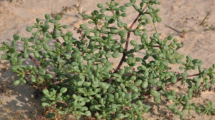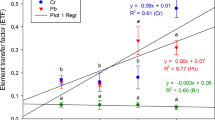Abstract
Keeping the sources of pollution such as chromium (Cr) under a safe limit is a daunting challenge due to the negative impact of heavy metal bioaccumulation in vegetation and the concomitant human health exposure. We took a closer look at Sonchus asper by cultivating in the green house. It resulted in 80% germination when cultivated over nine different soils collected from the tannery dump site. The biochemical analytical techniques such as mass spectrometry indicated significant bioaccumulation of Cr in the plant tissue. As per the ICP-MS analysis, this annual herb resulted in the accumulation of 601 mg kg−1 of total Cr with 212 mg kg−1 in its shoot from soil samples containing up to 41 mg kg−1 of hexavalent Cr. The energy dispersive X-ray (EDX) spectroscopy of S. asper revealed a higher level of S element indicating a sulfate-Cr binding relation. Elevated content of Cr in soil (73,721 ± 65 mg kg−1) caused biochemical changes in the shoot of S. asper as indicated by the disappearance of Fourier transform infrared spectroscopy (FTIR) bands at 935 and 872 cm−1 and further revealing aliphatic –CH2 appearing as anti-symmetry νa(CH2) and symmetric vibration νs(CH2) at the band of 2920 and 2850 cm−1, respectively.




Similar content being viewed by others
References
Adamczyk-Szabela D, Markiewicz J, Wolf WM (2015) Heavy metal uptake by herbs. IV. Influence of soil pH on the content of heavy metals in Valeriana officinalis land. Water Air Soil Pollut 226(4):106
Ali H, Khan E, Sajad MA (2013) Phytoremediation of heavy metals—concepts and applications. Chemosphere 91(7):869–881
Alloway BJ (2013) Sources of heavy metals and metalloids in soils. In: Heavy metals in soils. Springer, Netherlands, pp 11–50
Adriano DC (2001) Trace elements in terrestrial environments: biogeochemistry, bioavailability, and risks of metals. In: 2nd edition 2001. Springer Verlag, New York
Avudainayagam S, Megharaj M, Owens G, Kookana RS, Chittleborough D, Naidu R (2003) Chemistry of chromium in soils with emphasis on tannery waste sites. In: Ware GW (ed) Review in environmental contamination and toxicology, vol 178. Springer, New York, pp 53–91
Aryal R, Nirola R, Beecham S, Sarkar B (2016) Influence of heavy metals in root chemistry of Cyperus vaginatus R. Br: a study through optical spectroscopy. International Biodeterioration & Biodegradation 113:201–207
Bareen F, Khilji S (2008) Bioaccumulation of metals from tannery sludge by Typha angustifolia L. Afr J Biotechnol 7
Bartlett R, James B (1979) Behavior of chromium in soils: III. Oxidation. J Environ Qual 8(1):31–35
Boskey AL (2014) Infrared spectroscopy and imaging. Biomineralization sourcebook. CRC Press, Boca Raton, pp 47–58
Chen H, Arocena JM, Li J, Thring RW, Zhou J (2014) Assessments of chromium (and other metals) in vegetables and potential bio-accumulations in humans living in areas affected by tannery wastes. Chemosphere 112:412–419
Clemens S, Ma JF (2016) Toxic heavy metal and metalloid accumulation in crop plants and foods. Annu Rev Plant Biol 67:489–512
Ding C, Li X, Zhang T, Ma Y, Wang X (2014) Phytotoxicity and accumulation of chromium in carrot plants and the derivation of soil thresholds for Chinese soils. Ecotoxicol Environ Saf 108:179–186
Felcman J, Bragança MT (1988) Chromium in plants. Biol Trace Elem Res 17:11–16
Gardea-Torresdey J, De La Rosa G, Peralta-Videa J, Montes M, Cruz-Jimenez G, Cano-Aguilera I (2005) Differential uptake and transport of trivalent and hexavalent chromium by tumbleweed (Salsola kali). Arch Environ Contam Toxicol 48:225–232
Gardea-Torresdey J, Peralta-Videa J, Montes M, De La Rosa G, Corral-Diaz B (2004) Bioaccumulation of cadmium, chromium and copper by Convolvulus arvensis L.: impact on plant growth and uptake of nutritional elements. Bioresour Technol 92:229–235
Heredia-Guerrero JA, Benítez JJ, Domínguez E, Bayer IS, Cingolani R, Athanassiou A, Heredia A (2014) Infrared and Raman spectroscopic features of plant cuticles: a review. Front Plant Sci 5:305
Horny P, Lifshin E, Campbell H, Gauvin R (2010) Development of a new quantitative X-ray microanalysis method for electron microscopy. Microsc Microanal 16:821–830
Hall JL (2002) Cellular mechanisms for heavy metal detoxification and tolerance. J Exp Bot 53(366):1–11
Hou J, Liu GN, Xue W, Fu WJ, Liang BC, Liu XH (2014) Seed germination, root elongation, root-tip mitosis, and micronucleus induction of five crop plants exposed to chromium in fluvo-aquic soil. Environ Toxicol Chem 33(3):671–676
Hutchinson, I.A.N., Colosi, J. And Lewin, R.A., 1984. The biology of Canadian weeds.: 63. Sonchus asper (L.) hill and S. oleraceus L. Can J Plant Sci, 64(3), 731–744
Iqbal, M., Saeeda, S. & Shafiq, M. 2001. Effects of chromium on an important arid tree (Caesalpinia pulcherrima) of Karachi city, Pakistan. Ekologia (Slovak Republic)
Jaison S, Muthukumar T (2017) Chromium accumulation in medicinal plants growing naturally on tannery contaminated and non-contaminated soils. Biol Trace Elem Res 175(1):223–235
Jeruto P, Lukhoba C, Ouma G, Otieno D, Mutai C (2008) An ethnobotanical study of medicinal plants used by the Nandi people in Kenya. J Ethnopharmacol 116:370–376
Khan RA, Khan MR, Sahreen S (2012a) Protective effect of Sonchus asper extracts against experimentally induced lung injuries in rats: a novel study. Exp Toxicol Pathol 64:725–731
Khan RA, Khan MR, Sahreen S, Ahmed M (2012b) Evaluation of phenolic contents and antioxidant activity of various solvent extracts of Sonchus asper (L.) hill. Chem Cent J 6:1
Kuppusamy S, Thavamani P, Megharaj M, Venkateswarlu K, Lee YB, Naidu R (2016) Potential of Melaleuca diosmifolia leaf as a low-cost adsorbent for hexavalent chromium removal from contaminated water bodies. Process Saf Environ Prot 100:173–182
Löv Å, Sjöstedt C, Larsbo M, Persson I, Gustafsson JP, Cornelis G, Kleja DB (2017) Solubility and transport of Cr (III) in a historically contaminated soil–evidence of a rapidly reacting dimeric Cr (III) organic matter complex. Chemosphere 189:709–716
Lukina AO, Boutin C, Rowland O, Carpenter DJ (2016) Evaluating trivalent chromium toxicity on wild terrestrial and wetland plants. Chemosphere 162:355–364
Luzardo FH, Velasco FG, Alves CP, Correia IKDS, Cazorla LL (2015) Chemical characterization of agroforestry solid residues aiming its utilization as adsorbents for metals in water. Revista Brasileira de Engenharia Agrícola e Ambiental 19(1):77–83
Maine M, Hadad H, Sánchez G, Caffaratti S, Pedro M (2016) Kinetics of Cr (III) and Cr (VI) removal from water by two floating macrophytes. Int J Phytoremediation 18:261–268
Nikolić, G. S. & Cakic, M. D. 2011. Analysis of bioactive olygosaccharide-metal complexes by modern FTIR spectroscopy: copper complexes. Fourier transforms-new analytical approaches and FTIR strategies. InTech
Nirola R, Megharaj M, Aryal R, Naidu R (2016a) Screening of metal uptake by plant colonizers growing on abandoned copper mine in Kapunda, South Australia. Int J Phytoremediation 18(4):399–405
Nirola R, Megharaj M, Venkateswarlu K, Aryal R, Correll R, Naidu R (2016b) Assessment of metal toxicity and bioavailability in metallophyte leaf litters and metalliferous soils using Eisenia fetida in a microcosm study. Ecotoxicol Environ Saf 129:264–272
Nirola R, Megharaj M, Saint C, Aryal R, Thavamani P, Venkateswarlu K, Naidu R, Beecham S (2016) Metal bioavailability to Eisenia fetida through copper mine dwelling animal and plant litter, a new challenge on contaminated environment remediation. Int Biodeterior Biodegr 113:208–216
Nirola R, Mallavarapu M, Subramanian A, Palanisami T, Ramadass K, Aryal R, Saint C (2017) Analysis of chromium status in the revegetated flora of a tannery waste site and microcosm accumulation studies using earthworm E. fetida. Environ Sci Pollut Res 25:5063–5070. https://doi.org/10.1007/s11356-017-0543-8
Pulford I, Watson C, Mcgregor S (2001) Uptake of chromium by trees: prospects for phytoremediation. Environ Geochem Health 23:307–311
Rout GR, Samantaray S, Das P (2000) Effects of chromium and nickel on germination and growth in tolerant and non-tolerant populations of Echinochloa colona (L.) link. Chemosphere 40:855–859
Sallam AS, Usman AR, Al-Makrami HA, Al-Wabel MI, Al-Omran A (2015) Environmental assessment of tannery wastes in relation to dumpsite soil: a case study from Riyadh, Saudi Arabia. Arab J Geosci 8(12):11019–11029
Shahid M, Shamshad S, Rafiq M, Khalid S, Bibi I, Niazi NK, Dumat C, Rashid MI (2017) Chromium speciation, bioavailability, uptake, toxicity and detoxification in soil-plant system: a review. Chemosphere 178:513–533
Sen A, Mondal N, Mondal S (1994) Toxic effects of chromium (VI) on the plant Salvinia natans. Environ Ecol 12:279–283
Sharma D, Sharma C, Tripathi R (2003) Phytotoxic lesions of chromium in maize. Chemosphere 51:63–68
Shingel KI (2002) Determination of structural peculiarities of dexran, pullulan and γ-irradiated pullulan by Fourier-transform IR spectroscopy. Carbohydr Res 337:1445–1451
Shanker AK, Cervantes C, Loza-Tavera H, Avudainayagam S (2005) Chromium toxicity in plants. Environ Int 31(5):739–753
Sivakumar P, Kanagappan M, Das SSM (2016) Phytoremediation of tannery waste polluted soil using Hyptis suaveolens (Lamiaceae). Int J Pure and Applied Bioscience 4(1):265–272
Singh HP, Mahajan P, Kaur S, Batish DR, Kohli RK (2013) Chromium toxicity and tolerance in plants. Environ Chem Lett 11:229–254
Stasinos S, Zabetakis I (2013) The uptake of nickel and chromium from irrigation water by potatoes, carrots and onions. Ecotoxicol Environ Saf 91:122–128
Umadevi M, Avudainayagam S (2013) Effect of cadmium and chromium on fast growing pulp wood tree species. International Journal of Biosciences (IJB) 3:92–103
Vajpayee P, Sharma S, Tripathi R, Rai U, Yunus M (1999) Bioaccumulation of chromium and toxicity to photosynthetic pigments, nitrate reductase activity and protein content of Nelumbo nucifera gaertin. Chemosphere 39:2159–2169
van der Ent A, Baker AJ, Reeves RD, Pollard AJ, Schat H (2013) Hyperaccumulators of metal and metalloid trace elements: facts and fiction. Plant Soil 362(1–2):319–334
Zemleduch-Barylska A, Lorenc-Plucińska G (2015) Populus canescens grown on Cr-rich tannery waste: comparison of leaf and root biochemical and proteomic responses. Plant Physiol Biochem 90:1–13
Zou J, Wang M, Jiang W, Liu D (2006) Effects of hexavalent chromium (VI) on root growth and cell division in root tip cells of Amaranthus viridis L. Pak J Bot 38:673
Acknowledgements
The first author would like to thank Division Office, Research and Innovation Centre, NBERC UniSA for financial support and Dr. Binoy Sarkar, Future Industries Institute for providing FTIR analysis techniques.
Author information
Authors and Affiliations
Corresponding author
Additional information
Responsible editor: Elena Maestri
Rights and permissions
About this article
Cite this article
Nirola, R., Biswas, B., Megharaj, M. et al. Assessment of chromium hyper-accumulative behaviour using biochemical analytical techniques of greenhouse cultivated Sonchus asper on tannery waste dump site soils. Environ Sci Pollut Res 25, 26992–26999 (2018). https://doi.org/10.1007/s11356-018-2740-5
Received:
Accepted:
Published:
Issue Date:
DOI: https://doi.org/10.1007/s11356-018-2740-5




